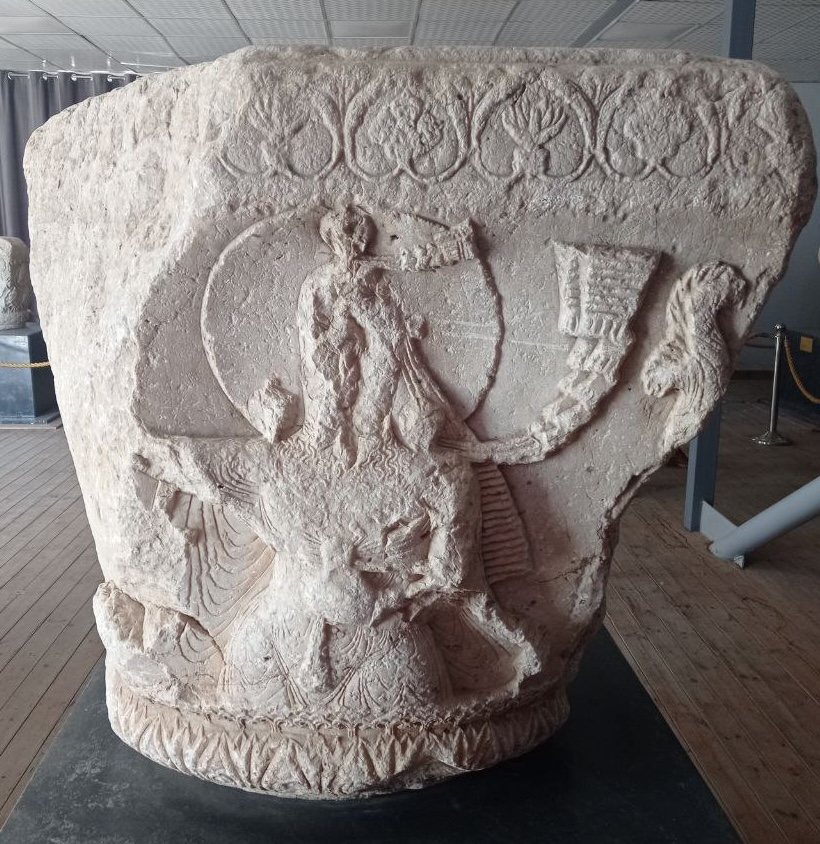Thread: I want to thank @realgavinlee for posting this pict of a very interesting, 1-3 C. AD Eastern Han Empire, bronze mirror.
The mirror is decorated with repeated scenes of "a tiger following a goat" and "a dragon facing a monkey". Except these are not ordinary decorations...


The mirror is decorated with repeated scenes of "a tiger following a goat" and "a dragon facing a monkey". Except these are not ordinary decorations...



These are animal calendar markers for
winter - "a tiger following a goat"
and
summer - "a dragon facing a monkey"
Tiger (winter) and Dragon (summer) are found as two opposing symbols in China since Neolithic Yangshao culture. I talked about this here:
oldeuropeanculture.blogspot.com/2021/08/tiger-…
winter - "a tiger following a goat"
and
summer - "a dragon facing a monkey"
Tiger (winter) and Dragon (summer) are found as two opposing symbols in China since Neolithic Yangshao culture. I talked about this here:
oldeuropeanculture.blogspot.com/2021/08/tiger-…

The reason for this kind of symbolic division of the calendar year is because of the climate in the North Eastern china: The climatic year is divided into cold, dry winter (tiger) and hot, wet summer (dragon)...Xian climate. But the climate for the whole Han area is very similar. 



Tiger is a winter symbol because the mating season of the Siberian / Amur tiger, which once lived in the North Eastern China, is Dec/Jan...Midwinter... 

Ibex is a winter symbol because Siberian ibex, which lives in North Eastern China starts mating in Oct/Nov and mates throughout the winter...
Which is why "tiger" (Dec/Jan) follows (comes after) goat (Oct/Nov)...
Which is why "tiger" (Dec/Jan) follows (comes after) goat (Oct/Nov)...

Snake is the only true solar animal. It is in our world when sun is in our world (day and hot part of the year) and it is in the underworld when sun is in the underworld (night and cold part of the year)...Hence snake as a symbol of the sun and more specifically of sun's heat... 

Now summer (Apr/May - Jul/Aug), the domain of the sun, starts with the beginning of the mating season of Eurasian viper snakes and ends with the beginning of the mating season of Eurasian lions... 



Dragon is also a symbol of sun, and sun's heat during the hottest time of the year, Jul/Aug...Which is why dragon is just "an old snake which looked at the sun for a long time". And why dragon was depicted as lion with snakes heads...Or snake with lion's head...
In Western Asia, North Africa, Europe, Jul/Aug is also the driest part of the year...The time of droughts...
Which is why in these parts of the world dragons breath fire, steal water and cause droughts and death...
And we have all the thunder gods chasing them away...
Which is why in these parts of the world dragons breath fire, steal water and cause droughts and death...
And we have all the thunder gods chasing them away...
But in China, the hottest part of the year is also the wettest part of the year...Xian climate again...
Hence in China, the fire breathing dragons bring rain...
oldeuropeanculture.blogspot.com/2021/08/chines…
Hence in China, the fire breathing dragons bring rain...
oldeuropeanculture.blogspot.com/2021/08/chines…

According to the Chinese mythology, dragon was helped in its water fetching duties by en.wikipedia.org/wiki/Kui_(Chin…, a "one-legged mountain demon or rain-god, variously said to resemble a Chinese dragon, a drum made of a skin of a water ox with no horns, or a monkey with a human face".
At first I wasn't sure what the dragon was facing on the Eastern Han mirror, but have a look at this:
Left: archaic oracle script symbol for "nao" (monkey)
Right: monkey from the Eastern Han mirror facing the dragon

Left: archaic oracle script symbol for "nao" (monkey)
Right: monkey from the Eastern Han mirror facing the dragon


The most common identification of this "monkey with the human face" is en.wikipedia.org/wiki/Golden_sn… Which is in China known as "Sichuan golden hair monkey" cause it lives in the mountains of Sichuan...Which was, I think, within the area of the core Han land... 



Now I think it is interesting that the monkey is facing, stopping the rain bringing dragon...Why? Have a look at the climate in Sichuan...The rain stops in October...And the mating season of the "Golden snub-nosed monkey" is...October... 

Oh yeah. Why "one legged mountain monkey/dragon rain god"? Apparently no one knows..."The Confucianists, detested the idea that K'ui had only one leg..." Cause they couldn't explain it. Maybe because... 

Or maybe because dragon, which is the symbol of the sun's heat during the hottest part of the year, late summer, is "just an old snake" which is the symbol of the sun's heat in general...And snakes only have "one leg", or none, depending how you look at it...
To see that I am not barking mad: Groot infers that the in "one-legged dragon" Kui, "which was amphibious, and caused wind and rain", "we immediately recognize the Dragon, China’s god of Water and Rain". Carr interprets this as "a crocodile-dragon with its tail seen as 'one leg'"
And, why was the thunder drum made from the hide of an "blue ox with no horns who comes out of the eastern sea"? Well, remember that the bull, ox, cow and calf, are animal calendar markers that mark the beginning of the calving season of the wild Eurasian cattle, Apr/May... 



Ox with no horns is a wild cattle calf...Which start being born in Apr/May...Which is when the summer monsoon winds arrive from the eastern sea carrying the clouds full of rain and thunder and lighting...Hence blue ox with no horns... 

• • •
Missing some Tweet in this thread? You can try to
force a refresh























